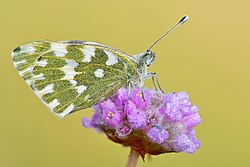| Eastern Bath white | |
|---|---|
 | |
| Istria, Croatia | |
| Scientific classification | |
| Kingdom: | Animalia |
| Phylum: | Arthropoda |
| Class: | Insecta |
| Order: | Lepidoptera |
| Family: | Pieridae |
| Genus: | Pontia |
| Species: | P. edusa |
| Binomial name | |
| Pontia edusa Fabricius, 1777 | |
| Synonyms | |
| |
Pontia edusa, the eastern Bath white, is a butterfly in the family Pieridae.


